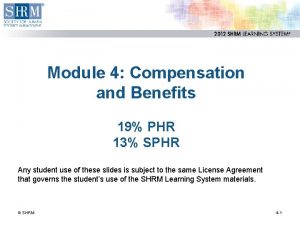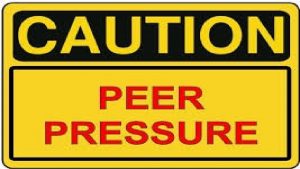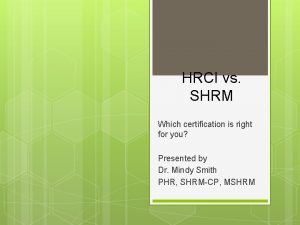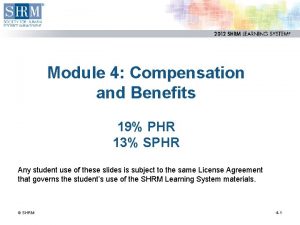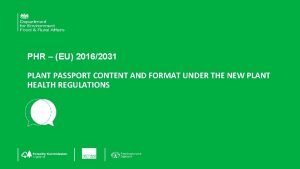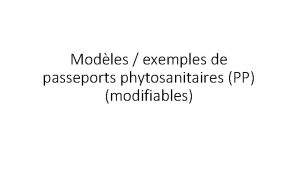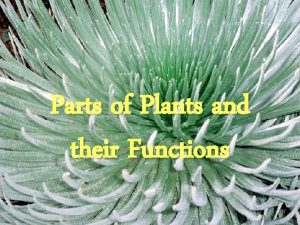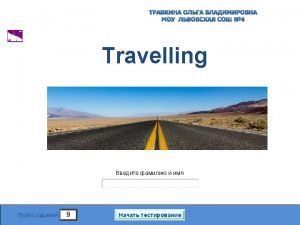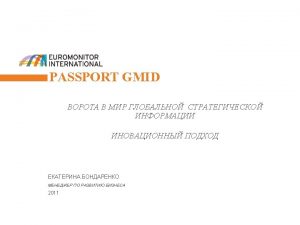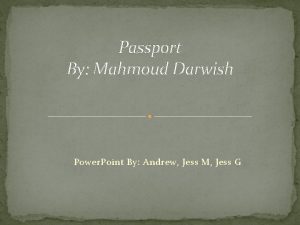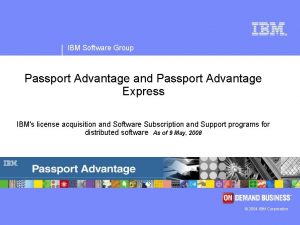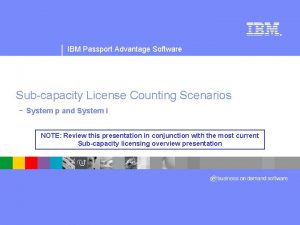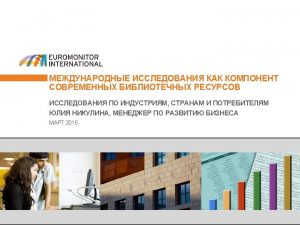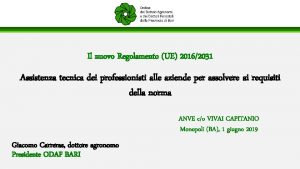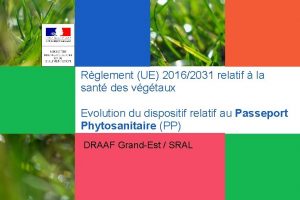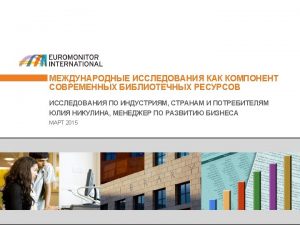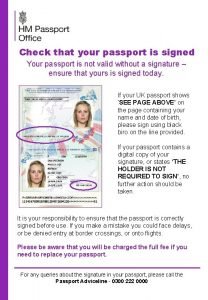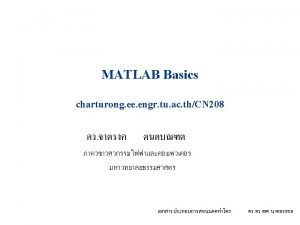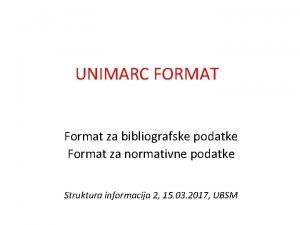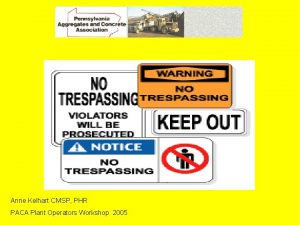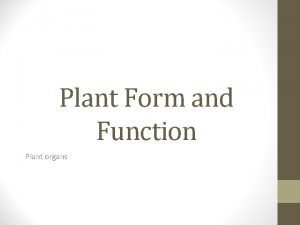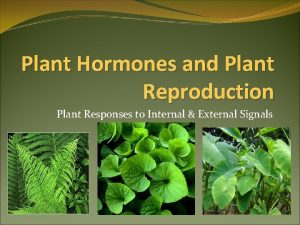PHR EU 20162031 PLANT PASSPORT CONTENT AND FORMAT























- Slides: 23

PHR – (EU) 2016/2031 PLANT PASSPORT CONTENT AND FORMAT UNDER THE NEW PLANT HEALTH REGULATIONS

Contents v EU Plant Passports: An Introduction v The difference between a Plant Passport (PP) and a Phytosanitary Certificate (PC) v What plants and plant products require a PP? v What information is required: o For a standard PP? o For a PP for a Protected Zone (PZ)? o For a PP merged with an existing Certification Label? v Becoming authorised to issue PPs v Where do I attach a PP? v Contacts and links to further information and resources 2

EU Plant Passports: An Introduction v What is a PP? o A PP is an official label for the movement of regulated plants and plant products within the EU, and where applicable, into and within EU PZs. It assures compliance with all plant health requirements for the relevant plant or plant product, for example that it is free from particular pests and diseases. o The content and format of PPs is outlined on GOV. uk and is also publicly available on EUR-LEX is the site where EU law is published. v What is the purpose of a PP? o PPs ensure that plants and plant products can be traced throughout the supply chain, which is essential for maintaining biosecurity. The PP regulations are applied across the EU, which means stakeholders in all EU states must uphold the same minimum standards for plant health. o The new format provides better recognisability and consistency across the EU. o The new PP regulations will raise awareness of plant health. 3

EU Plant Passports: An Introduction v What is a PP for a PZ? o PPs for PZs are required for plant and plant products which are known to host certain quarantine pests or diseases not present in certain PZs. o A PP for a PZ provides greater assurance that the plant or plant product is free from the relevant pest when entering the PZ. o Each PZ pest has its own unique code which must be listed on the PP for the PZ. o More details on the format of a PP for a PZ can be found on slide 11. 4

What is the difference between a PP and a PC? v A PC is a global certificate used for biosecurity purposes, and is necessary for regulated plants and plant products imported into the UK from 3 rd countries (non-EU countries) or exported from the UK to 3 rd countries. v PCs are issued by the competent authority. In England Wales this is APHA (Animal & Plant Health Agency), in Scotland it is SASA and in Northern Ireland DAERA (Department of Agriculture, Environment and Rural Affairs). v A PP is for internal movements within the EU alone, and is an EU specific label. v PPs are issued by authorised operators (authorisation is granted by the competent authority). v The list of plants and plant products which require a PC is not the same as the list for those that require a PP.

What plants and plant products will require a PP? v Under the new regulations the scope of what will require a PP will be greater than before. v PPs will be needed down to retail level. Plants sold through distance contracts (e. g. online or over the phone) and some plants for which a PZ PP are required will need a PP provided even to the final user. The list of plants with PZ status and which will require a PP provided to the final user is under discussion between the European Commission and Member States. We will provide further guidance soon. v The new list will includes but is not limited to: • all plants for planting (plants intended to remain planted, to be planted or to be replanted) • some seeds • seed potatoes • some fruits with peduncles attached v The complete list can be found here. v The list of plants and plant products which require a PZ PP can be found here.

What information is required for a standard PP? Part 1: The following elements must be provided in all PPs, unless the passport has been combined with a certification label which already includes this information, in which case only the EU flag and reference to ‘Plant Passport’ is needed. v The EU flag, which may be printed in colour, or in black and white, either with white stars on black background, or vice versa, and must be in the top left hand corner of the PP. v The words 'Plant Passport' in English and, if relevant, in one other official language of the Union, to be separated by a slash. v The botanical name(s) of the plant(s) species or taxon(s) concerned, in the case of plants and plant products, or, where appropriate, the name of the object concerned, and, optionally, the name of the variety. v If you are unsure of the correct botanical name of the plants you trade in, see the RHS guide here for help or ask your local PHSI. 7

What information is required for a standard PP? Part 2: v The two-letter code for the Member State in which the professional operator issuing the PP is registered. The code for the UK (including Northern Ireland) is GB. These two-letter codes can be found on GOV. UK. v The alphabetical, numerical or alphanumerical national registration number of the professional operator concerned. v The traceability code of the plant, plant product or the other object concerned (this can be an existing code used to trace or identify a consignment). This code must provide traceability back to the operator who issued the PP. v All passported plants require traceability codes if they are not ready and prepared for the final user. v Some plants and plant products require traceability codes in all cases. The list of these plants is under consultation until 10 January 2020 and is available here. 8

What information is required for a standard PP? Part 3: v Where applicable, the two-letter code of the Member State(s) or where applicable, the name(s) of the third country/countries of origin or its/their two-letter code. These two-letter codes can be found on GOV. UK. v Information on when Country of Origin changes to GB can be found on GOV. uk, under Part D of ‘Making a Plant Passport’. Other information: v The PP may include a unique barcode, QR-code, hologram, chip or other data carrier, supplementing the traceability code. This is requirement is optional. v Please note that the size of the PPs, the use of a border line, the proportions of the size of their elements, and the fonts used in the models on the following slides are only examples. v The information in PPs must be legible, but can be handwritten, as long as it is written in capitals. v The PP must be distinct and separate from other information associated with the consignment, e. g. care instructions. 9

Standard PP Examples • The words ‘Plant Passport’ 1 • Botanical names 2 (A) • Country code of issuer 3 (B) • Registration number 4 (B) • Traceability code 5 (C) • Country of origin code (EU Member State or 3 rd country) 7 or 8 (D) • Barcode or similar (optional) The size of the PPs, the use of a border line, the proportions of the size of their elements, and the fonts used in the models are only examples.

Standard PP Examples • The words ‘Plant Passport’ 1 • Botanical names 2 (A) • Country code of issuer 3 (B) • Registration number 4 (B) • Traceability code 5 (C) • Country of origin code (EU Member State or 3 rd country) 7 or 8 (D) • Barcode or similar 6 (optional) The size of the PPs, the use of a border line, the proportions of the size of their elements, and the fonts used in the models are only examples.

What information is required for PPs for PZs? Part 1: v The PP for the PZ must still contain the elements set out in slides 7 and 8, and the information on slide 9 still applies. v A ‘Protected Zone’ or PZ is an area designated as free from a particular quarantine pest(s). The PZ PP attests that the plant or plant product in question is free from the relevant PZ quarantine pest. v The detailed list of plants, plants products and other objects for which a PP is required for a PZ is on GOV. uk. 12

What information is required for PPs for PZs? Part 2: The following elements must be provided in all PPs for PZs, unless the passport has been combined with a certification label which already includes this information, in which case only the EU flag and reference to ‘Plant Passport’ is needed. v The words 'Plant Passport – PZ' in English and, if relevant, in one other official language of the Union, to be separated by a slash. v Scientific name(s) of PZ quarantine pest(s) or, alternatively, the EPPO codes specifically attributed to those pests. The scientific names and EPPO codes of the relevant pests can be found here. 13

PP for a PZ Format • The words ‘Plant Passport PZ’ 1 • Botanical names 2 (A) • Country code of issuer 3 (B) • Registration number 4 (B) • Traceability code 5 (C) • Country of origin code (EU Member State or 3 rd country) 7 or 8 (D) xxxxx – XX / Plant Passport – PZ 1 xxx 9 • Barcode or similar 6 (optional) • PZ Code 9 A xxxxx 2 B XX 3 – xxxxx 4 C xxxxx 5 D XX 7 or 8 The size of the PPs, the use of a border line, the proportions of the size of their elements, and the fonts used in the models are only examples.

PP for a PZ Format • xxxxx–XX/ Plant Passport – PZ 1 PZ’ 1 xxx 9 xxxxx – XX /Plant Passport – PZ 1 A xxxxx 2 B XX 3 – xxxxx 4 C xxxxx 5 D XX 7 or 8 6 The words ‘Plant Passport – xxx 9 A xxxxx 2 B XX 3 – xxxxx 4 • Botanical names 2 (A) • Country code of issuer 3 (B) • Registration number 4 (B) • Traceability code 5 (C) • Country of origin code (EU C 5, 6 D XX 7 or 8 Member State or 3 rd country) 7 or 8 (D) • Barcode or similar 6 (optional) • PZ Code 9 The size of the PPs, the use of a border line, the proportions of the size of their elements, and the fonts used in the models are only examples.

What information is required? For products which also require a certification label: v The plant passport is merely combined with the certification label, with the EU flag, the words ‘Plant Passport’, and if applicable the PZ code, above the certification label information. v A list of seeds for which a PP combined with a certification label is required will be available soon. v This information does not need to be repeated in the PP as information required in elements 2 -8 (see list below), as described in the previous examples, will be provided by the certification label itself. • The words ‘Plant Passport’ 1 • • Botanical names 2 (A) • Country of origin code 7 or 8 (D) • Country code of issuer 3 (B) • Barcode or similar 6 (optional) • Registration number 4 (B) Traceability code 5 (C) 16

PPs combined with a certification label Standard PP • The words ‘Plant Passport’ 1 • PZ Code 9 • Information needed for certification label 10 PP for a PZ The size of the PPs, the use of a border line, the proportions of the size of their elements, and the fonts used in the models are only examples.

PPs combined with a certification label xxxxx – XX / Plant Passport – PZ 1 xxx 9 xxxxxxx 10 • The words ‘Plant Passport’ 1 • PZ Code 9 6 • Information needed for certification label 10 • Barcode or similar 6 (optional) xxxxx / Plant Passport 1 xxxxxxx 10 6 The size of the PPs, the use of a border line, the proportions of the size of their elements, and the fonts used in the models are only examples.

How do I become authorised to issue PPs? v Anyone dealing professionally in plants and plant products must be registered with the competent authority. Only those issuing PPs must be authorised to do so. v Details on the process of authorisation can be found on GOV. uk. v Details on who needs to become authorised can be found in our flow charts on the Plant Health Portal here. 19

Where do I attach my PP? v In most cases a PP will not need to be attached to each individual pot. v The PP must be attached to the smallest trade unit at the relevant marketing stage. The PP must be attached prior to movement. v If a business sells the same commodity on pallets, trays, or in bags, the PP must be attached to each of those individual units. However if there are multiple commodities on the same pallet or tray then the PP must be attached to the individual units, e. g. bundles or bags, on that pallet. v Multiple plant species can be listed on a single PP as long as traceability is provided for all regulated plants or plant products listed on the PP. v The traceability code of the plant, plant product or the other object concerned can be an existing code used to trace or identify a consignment, as long as it provides traceability for all the regulated commodities within the relevant trade unit. 20

Where do I attach my PP? v If you are supplying directly to retail a single plant passport can cover a single trolley of plants as long as traceability can be maintained for the plants and plant products on that trolley. In such cases the PP could cover an unlimited number of species on that trolley, however the PP must be attached to that trolley and be travelling to a single destination. v Trolleys moving at other stages in the supply chain could be covered by a single PP only if the plants on that trolley were of the same specie, and going to the same destination. v If you are selling through distance contracts (e. g. online), and must supply a final user, the PP may be attached to the box or the plant pot in question. 21

Contact v For further information please see the below contacts. v For customers in England Wales, email SRSF@apha. gov. uk. v For customers in Scotland contact SASA. Phone: 0131 244 8923 Email: hort. marketing@gov. scot v For customers in Northern Ireland contact DAERA Phone: 0300 200 7847 Email: planthealth@daera-ni. gov. uk 22

Further Information v Plant passport factsheet available here. v GOV. uk guidance on issuance of plant passports available here. This includes how to become authorised, how to make a PP and the lists of plants and plant products which require a PP. v Plant passport flow chart on who needs to be authorised available here. v Plant passport Question and Answers available here. v Plant passports and seed factsheet available here. v Plant passports and forestry guidance here. 23
 Phr
Phr Spoken peer pressure
Spoken peer pressure Emr ehr phr
Emr ehr phr Phr.v
Phr.v Shrm certification vs hrci
Shrm certification vs hrci Mental health equity
Mental health equity Plant passport codes
Plant passport codes Plant passport eu
Plant passport eu Real content and carrier content in esp
Real content and carrier content in esp Static content vs dynamic content
Static content vs dynamic content Tronsmo plant pathology and plant diseases download
Tronsmo plant pathology and plant diseases download Tronsmo plant pathology and plant diseases download
Tronsmo plant pathology and plant diseases download Tronsmo plant pathology and plant diseases download
Tronsmo plant pathology and plant diseases download Plant introduction in plant breeding
Plant introduction in plant breeding Plant introduction in plant breeding
Plant introduction in plant breeding Plant introduction in plant breeding
Plant introduction in plant breeding Parts of a plants and their functions
Parts of a plants and their functions It can be quite busy here during the tourist
It can be quite busy here during the tourist Euromonitor international
Euromonitor international Passport poem
Passport poem Tccp student passport
Tccp student passport Ibm software passport advantage
Ibm software passport advantage Ibm software passport advantage
Ibm software passport advantage Ibm passport advantage
Ibm passport advantage
